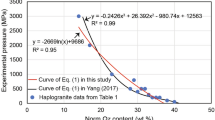Abstract
Fluorine-, boron- and phosphorus-rich pegmatites of the Variscan Ehrenfriedersdorf complex crystallized over a temperature range from about 700 to 500 °C at a pressure of about 1 kbar. Pegmatite quartz crystals continuously trapped two different types of melt inclusions during cooling and growth: a silicate-rich H2O-poor melt and a silicate-poor H2O-rich melt. Both melts were simultaneously trapped on the solvus boundaries of the silicate (+ fluorine + boron + phosphorus) − water system. The partially crystallized melt inclusions were rehomogenized at 1 kbar between 500 and 712 °C in steps of 50 °C by conventional rapid-quench hydrothermal experiments. Glasses of completely rehomogenized inclusions were analyzed for H2O by Raman spectroscopy, and for major and some trace elements by EMP (electron microprobe). Both types of melt inclusions define a solvus boundary in an XH2O–T pseudobinary system. At 500 °C, the silicate-rich melt contains about 2.5 wt% H2O, and the conjugate water-rich melt about 47 wt% H2O. The solvus closes rapidly with increasing temperature. At 650 °C, the water contents are about 10 and 32 wt%, respectively. Complete miscibility is attained at the critical point: 712 °C and 21.5 wt% H2O. Many pegmatites show high concentrations of F, B, and P, this is particularly true for those pegmatites associated with highly evolved peraluminous granites. The presence of these elements dramatically reduces the critical pressure for fluid–melt systems. At shallow intrusion levels, at T ≥ 720 °C, water is infinitely soluble in a F-, B-, and P-rich melt. Simple cooling induces a separation into two coexisting melts, accompanied with strong element fractionation. On the water-rich side of the solvus, very volatile-rich melts are produced that have vastly different physical properties as compared to “normal” silicate melts. The density, viscosity, diffusivity, and mobility of such hyper-aqueous melts under these conditions are more comparable to an aqueous fluid.
Similar content being viewed by others
Author information
Authors and Affiliations
Additional information
Received: 15 September 1999 / Accepted: 10 December 1999
Rights and permissions
About this article
Cite this article
Thomas, R., Webster, J. & Heinrich, W. Melt inclusions in pegmatite quartz: complete miscibility between silicate melts and hydrous fluids at low pressure. Contrib Mineral Petrol 139, 394–401 (2000). https://doi.org/10.1007/s004100000120
Published:
Issue Date:
DOI: https://doi.org/10.1007/s004100000120




